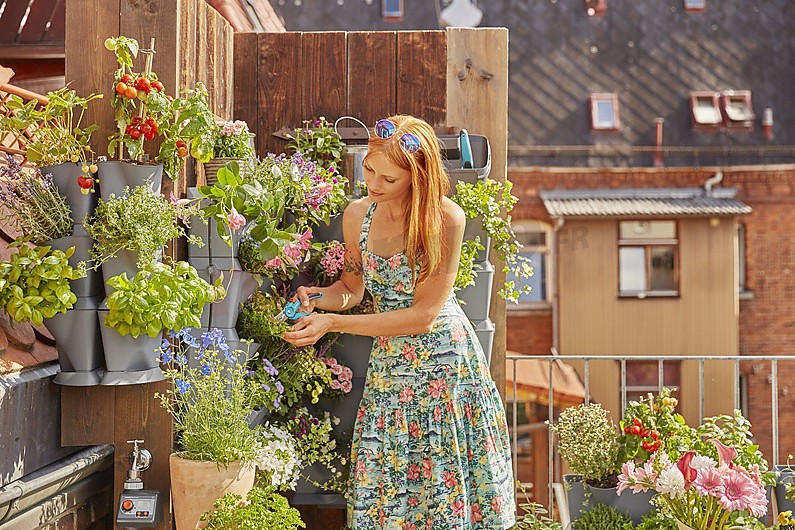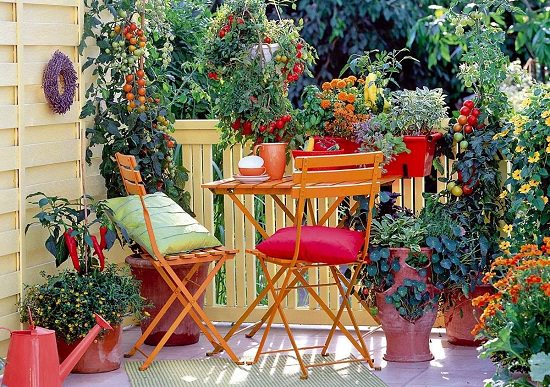
You might be among the fortunate couple of who occurs to have a correct garden area, but if you’re like me, you do not.
Many individuals reside in little areas or houses, and we do not have an outside plot to claim. However do not give up hope! You can grow a patio area garden in very little space and enjoy wonderful, fresh veggies and herbs.
Patio or veranda gardens are ending up being popular, specifically as more people move to the city. Whether you have a green thumb or are just wanting to add a new hobby to your quiver, it’s an excellent thing to do. You can grow a remarkably big quantity of scrumptious food in a small space if you plan properly.
We’ll take a look at some ways to optimize your area and yield, even if you just have a patch of dirt the size of a postage stamp to work with. We’ll take a look at container veggie gardening, however we’ll look at some other approaches, also.
Considerations of Small Spaces
If you are going to do some veggie gardening utilizing containers, tables, planters, or bags, and you don’t have a ton of area to work with, here are some things to consider:
Optimize Sunlight: With small areas, especially balconies, plants can struggle with an absence of light. There are ways to handle this, primarily by noticing where the light originates from and maximizing it. If you require to vertically stack your grow containers, make certain that the shadow of the leading one does not obstruct light to those beneath.
With very restricted space and light, a pallet garden might be the ideal concept for you. (They’re much better for her than veggies).
Presentation is Key: A container-style garden is an excellent idea for a patio, but just if it doesn’t make your outside space unmanageable. You still need access to the area, and there’s no factor it need to feel cluttered. (In a moment, I’ll review some terrific planters and setups to ensure your little garden is perfectly provided and easy to preserve and take pleasure in.).
Weight Restrictions: Garden containers can be quite heavy, so this is a crucial factor to consider for anyone intending to put one on a veranda. Be sure that you don’t exceed the weight limitations of your balcony or deck.
Potato barrels, for instance, can weigh hundreds of pounds when watered. It generally isn’t a concern unless you’re trying to begin a high-yield pastime farm on your terrace.
1) Table Planters: Easy, Attractive and Accessible.
No dirt? No issue! A smart and reliable table planter is an apartment or condo garden enthusiast’s dream! It provides a good amount of soil and fits on your veranda.
The great thing about a raised bed is that it really works. You’ve got a good quantity of area to work with, so you can have a good quantity of dirt in the planter itself. It can even be built waist high, which suggests you do not have to flex down and hurt your back when you’re tending to it.
It has at least 11 inches of depth for your soil, so you have access to about 8 cubic feet to plant in! That’s a fair bit. It’s not truly enough to grow potatoes in, but it’s substantial all the same. Tomatoes, lettuce, and zucchini ought to all succeed.
2) Vertical Planters: The Ultimate Space-Saver.
Remember the issues I pointed out with little areas and absence of light? Here is a fantastic solution! A vertical planter is perfect for a wide array of herbs and veggies. It decreases the area requirements while maximizing veggie output, and possibly most notably they look amazing.
This is a very similar concept to pallet gardening, where it’s intended to lean up versus a wall. The advantage here is that it’s much more well developed than a pallet, and it looks a lot much better and more ‘fine-tuned.’.
These can be made in natural cedar that will age perfectly on your patio area or deck. It’s pretty flexible, boasting many tiers and a ‘penthouse’ leading shelf for plants that require more sun.
It also makes it possible for a drip irrigation system, suggesting that you don’t have to water each tier. Simply water the top, and it will drip down to each plant. That’s a good thing, because it avoids root rot, too.
This style of planter is definitely planned for plants that don’t need too much soil. Lettuce, basil, parsley, and oregano would do very well here. Tomatoes might grow here too, however be warned that tomato roots are aggressive and will overtake other plants.
3) Multi-Tiered Pots: Grow Lots of Different Things simultaneously.
If you do not have a lot of square footage, you need to be innovative with what you have. That’s why stackable planter pots make plenty of sense. Just like the vertical plane, you’re making use of that underutilized vertical square video footage.
It features a variety of space-saving advantages: It can either rest on the ground or hang from a chain, and it allows a flow-through irrigation system that lets you water the system just as soon as, rather than needing to water each plant pod individually.
It allows plants to grow vertically. The planting areas are not big, so don’t anticipate growing potatoes or carrots in them, however they’re a great size for most herbs, cherry tomatoes, strawberries, and other similar veggies and fruits.
If you get tired of growing veggies in it, feel totally free to switch over to flowers.

4) Potato Bags: Perfect for Growing Spuds and Root Vegetables.
Potatoes typically require an excellent amount of soil, since they’re a root veggie– that makes veggie gardening tricky on a veranda.
Conceptually, it’s splendidly simple. The bags are made of a felt-like material that is light and flexible, yet strong enough to hold in the dirt and plant. The material is breathable and porous, so the roots are oxygenated and the soil temperature is more conducive to development. The product also permits excess water to escape, which prevents overwatering.
Note: If you’re going on a terrace, be conscious that these bags leakage! They’re implying to. If that’s an issue, you’re better off to put the bag within a waterproof container. For places where the ground can get damp, you’re fine to just grow the potatoes or carrots in the bag and let the water leak out.
Even on a veranda, deck or patio vegetable garden, you’ll get an excellent yield of potatoes with these inexpensive, light, clever, and multiple-use bag planters.
5) Recycled Plastic Wall Planter Pockets.
Okay, so what if your patio space is maxed out and there’s nowhere else to grow? You can always grow herbs on the wall with these 100% recycled plastic wall bag planters. It’ll work anywhere you can hang it, and there are a number of alternatives if this specific model does not fit you.
By positioning a hanging material wall planter in a spot that gets a lot of sun, you can easily grow herbs like basil, oregano, mint, or dill. It does not take up any important flooring space and you’ll get lots of positive comments from guests due to the fact that it looks excellent.
I ‘d recommend hanging them from a wall, a fence, or from the railing of your terrace, if you have one. (Check your building bylaws first though.).
The principle is quite simple, and if you’re helpful with a stitching device you could probably make your own.
Keep in mind: Like the potato bags, a material pocket launches excess water onto the ground, so you’ll want to ensure it has sufficient drainage or simply water carefully.
What Can I Grow on a Balcony Veggie Garden?
You ‘d be amazed what you have the ability to grow in even the smallest area. A lot of container vegetables aren’t going to be as big or robust as those grown in the ground, but you can do rather well. I’ve seen some substantial tomatoes, carrots, and zucchini grown in really small spaces.
You’ll be amazed by the yield, too. Herbs in particular seem to do well when they’re provided a little sun and area. We had more basil than we could eat in 2015, all from one little plant on our terrace. We had the ability to make several jars of pesto at the end of the season!
Do take care of pests like thrips and aphids. In a big space they’re not as harmful, however an aphid infestation can devastate your small garden in no time flat.